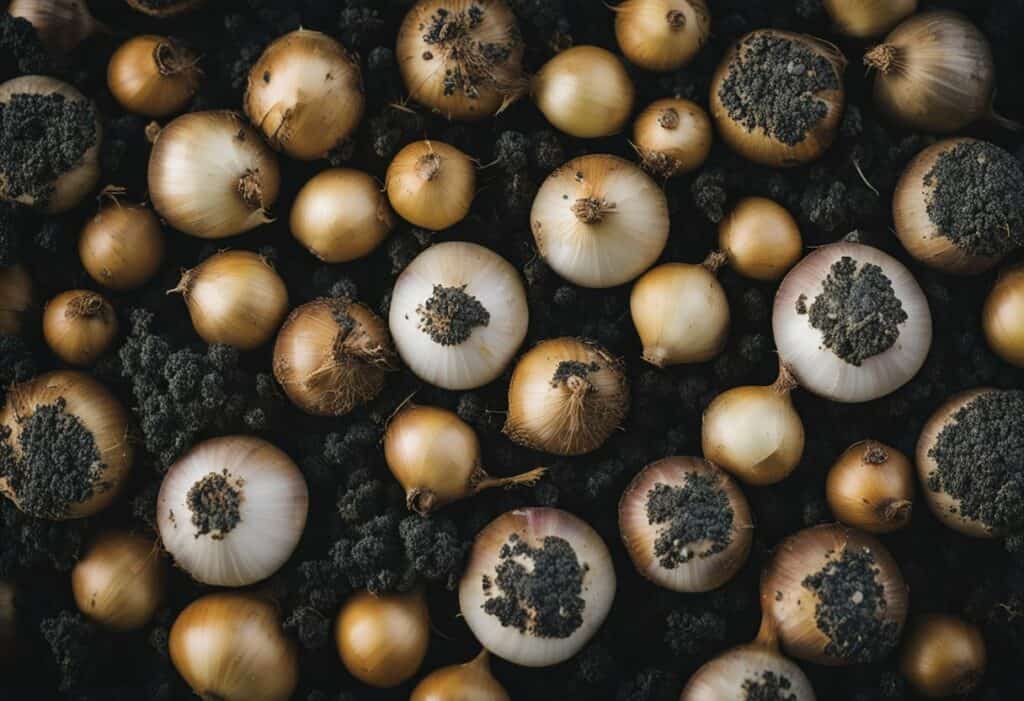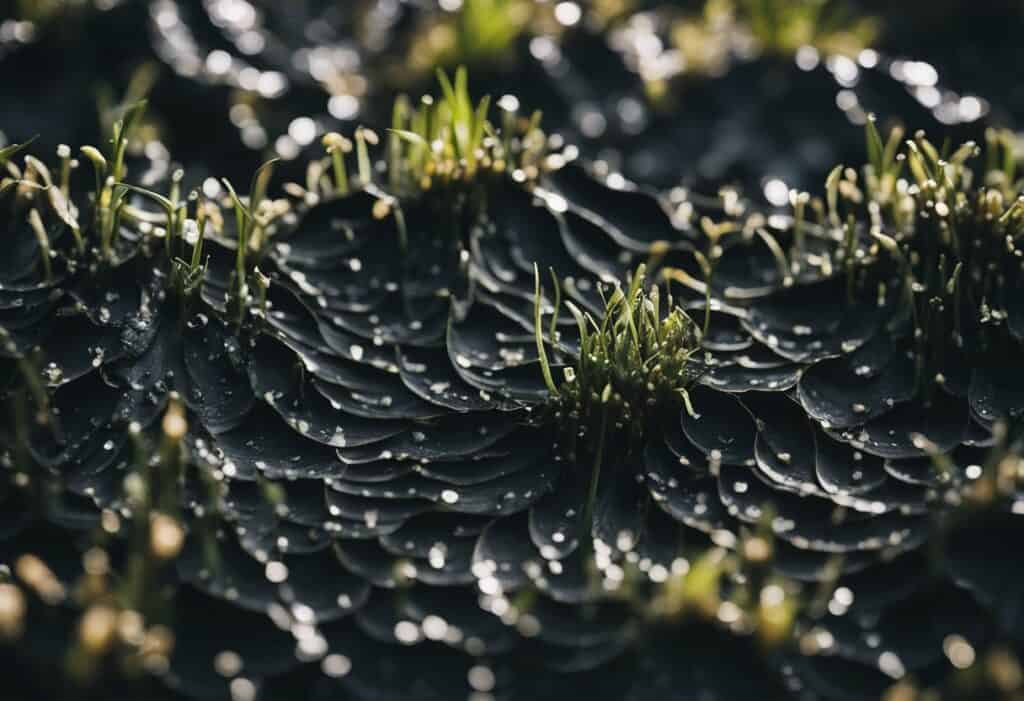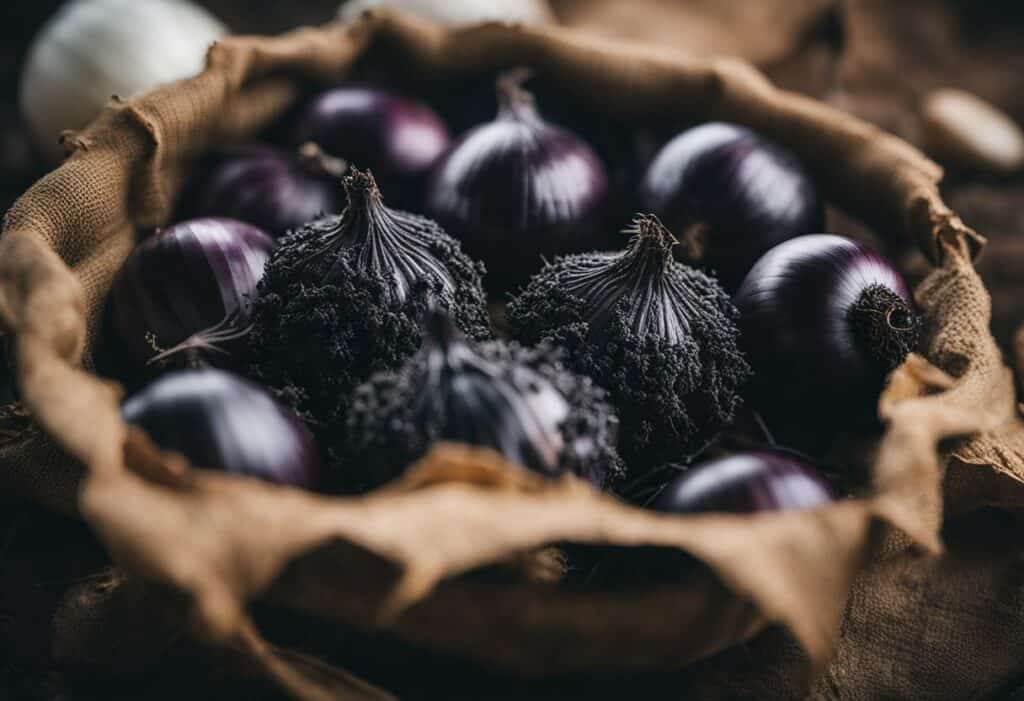Black mold on onions is a common problem that many people encounter. It can be alarming to see black spots or lines on the surface of onions, but it doesn’t necessarily mean that the onion is spoiled or unsafe to eat.
In fact, black mold on onions is caused by a fungus that is present in the air and soil, and it can be managed with proper storage and handling techniques.

Identifying black mold on onions is relatively easy. The mold appears as black spots or lines on the surface of the onion, and it can also cause the onion to become soft or mushy.
While black mold on onions is not harmful to most people, it can cause an allergic reaction in some individuals. Therefore, it’s important to take proper precautions when handling onions that have black mold.
Overall, black mold on onions is a common problem that can be managed with proper storage and handling techniques.
By understanding the causes and effects of black mold on onions, as well as how to prevent and manage it, you can ensure that your onions are safe and healthy to eat.
Key Takeaways
- Black mold on onions is caused by a fungus that is present in the air and soil.
- While black mold on onions is not harmful to most people, it can cause an allergic reaction in some individuals.
- Proper storage and handling techniques can help prevent and manage black mold on onions.
Identifying Black Mold on Onions
As a food lover, I always want to ensure that the ingredients I use are fresh and safe for consumption. One of the common issues that I have encountered while using onions is the presence of black mold.
Black mold on onions is caused by a fungus called Aspergillus niger.
This fungus thrives in damp environments, so if your onions are stored in a moist or humid area, they are more likely to develop black mold.
To identify black mold on onions, look for black spots or black discoloration on the skin or inner layers of the onion.
The black substance may be powdery or sooty in texture and may appear in clusters, dots, or smudges.
If you notice any of these signs, it is best to discard the onion as it may not be safe for consumption.
It is important to note that consuming onions with black mold can be harmful. The fungus can produce mycotoxins, which can cause health problems such as nausea, vomiting, and respiratory issues.
Therefore, it is crucial to inspect onions thoroughly before use and discard any with signs of black mold.
To prevent black mold from developing on onions, store them in a cool, dry, and well-ventilated area. Avoid storing onions in plastic bags or containers as they can trap moisture and promote the growth of mold.
Instead, store onions in a mesh bag or a paper bag with holes to allow air circulation.
In conclusion, identifying black mold on onions is crucial to ensure the safety of the ingredients used in cooking.
By following proper storage methods and inspecting onions before use, we can prevent the growth of black mold and ensure that the ingredients used in our meals are fresh and safe for consumption.
Causes of Black Mold in Onions
Black mold on onions is caused by a type of fungus known as Aspergillus niger. This fungus is commonly found in soil and air, and it can grow on onions when they are stored in conditions that are too moist or warm.
Mold can also grow on onions that have been bruised or injured during harvesting or storage. When the outer scales of the onion are damaged, it creates an entry point for mold spores to enter and grow.
Temperature fluctuations and high humidity levels can also contribute to the growth of mold on onions. Onions should be stored in a cool, dry place with good air circulation to prevent mold growth.
Mold can also occur in the field when onions are at or near maturity. If the soil is too moist or the weather is too humid, it can create conditions that are ideal for mold growth.
To prevent mold growth on onions, it is important to store them in a cool, dry place with good air circulation. Onions should also be inspected regularly for signs of mold and discarded if any mold is found.
If only the outer scales of the onion are affected by mold, they can be rinsed off under cool, running tap water or cut off. The unaffected part of the onion can still be used.
In summary, black mold on onions is caused by a type of fungus that can grow on onions when they are stored in conditions that are too moist or warm, or when they are bruised or injured.
To prevent mold growth, it is important to store onions in a cool, dry place with good air circulation and to inspect them regularly for signs of mold.
Effects of Black Mold on Onions

Black mold on onions is a soft rot disease caused by the fungus Aspergillus niger. It is a common type of mold that can grow on onions during storage or when they are exposed to humid and warm conditions.
While black mold on onions is not harmful to everyone, it can cause health problems for some people, especially those with allergies or weakened immune systems.
If you eat moldy onions, you may experience symptoms such as diarrhea, vomiting, nausea, headaches, and stomach pain.
Some molds are incredibly toxic and can be fatal. Therefore, it is essential to discard moldy onions and not use them for cooking or stock.
It is also important to note that black mold on onions can produce toxins that can affect your health. These toxins can cause respiratory problems, skin irritation, and other health issues.
Therefore, it is crucial to handle moldy onions with care and avoid inhaling their spores.
In conclusion, black mold on onions is a common problem that can affect the quality and safety of your food. While it may not be harmful to everyone, it can cause health problems for some people.
Therefore, it is essential to discard moldy onions and not use them for cooking or stock. If you have allergies or weakened immune systems, it is best to avoid moldy onions altogether.
Preventing and Managing Black Mold

As a gardener, I have learned that black mold on onions is a common problem that can occur both before and after harvest.
The fungus Aspergillus niger is a common cause of black mold on onions, including moldy spots, streaks, or patches. It is also the same fungus responsible for black mold on garlic.
To prevent black mold, it is essential to manage and control it. Here are some tips that I have found to be helpful in preventing and managing black mold on onions:
Pre-Harvest Management
- Careful Handling: Handle onions with care to avoid bruising and damage that can create entry points for fungi.
- Fungicides: Apply fungicides to protect onions from fungal diseases.
- Drainage: Ensure proper drainage in the fields to prevent excess moisture that can promote fungal growth.
Post-Harvest Management
- Drying: Dry onions properly before storage to prevent excess moisture that can promote fungal growth.
- Transport: Handle onions gently during transportation to prevent bruising and damage that can create entry points for fungi.
- Storage: Store onions in a cool, dry, and well-ventilated place to prevent excess moisture that can promote fungal growth.
Managing Black Mold
- Rinse Off Small Amounts of Mold: Rinse off small amounts of black mold on the outer scales of the onion under cool, running tap water or cut off the affected layers. The unaffected part can be used.
- Discard Moldy Areas: Do not eat moldy areas or use them for stock; discard them.
- Use Fungicides: Apply fungicides to prevent and manage black mold on onions.
By following these tips, I have been able to prevent and manage black mold on onions effectively. However, it is essential to note that prevention is always better than cure.
Therefore, it is crucial to take the necessary measures to prevent black mold from occurring in the first place.
Relation of Black Mold with Other Onion Diseases
Black mold is a common post-harvest disease of onions, caused by the fungus Aspergillus niger. It can occur in the field when the bulbs are at or near maturity, but it most commonly affects bulbs in storage.
While black mold is a distinct disease, it can also be associated with other onion diseases, such as downy mildew and foliar diseases.
Downy mildew is caused by the fungus Peronospora destructor and is a common disease of onions. It affects the foliage of the plant, causing yellowing and wilting of the leaves.
The disease can also cause the onion bulbs to rot in storage. While downy mildew is a different disease than black mold, it can create conditions that are favorable for black mold development.
For example, the fungus can weaken the onion plant, making it more susceptible to black mold infection.
Foliar diseases, such as purple blotch and bacterial leaf blight, can also be associated with black mold. These diseases affect the leaves of the onion plant and can cause yellowing, wilting, and spotting.
Like downy mildew, foliar diseases can weaken the plant and make it more susceptible to black mold infection.
It is important to note that while black mold can be associated with other onion diseases, it is still a distinct disease that requires specific management practices.
These practices include maintaining stable temperatures during transport and storage, avoiding temperature fluctuations that can cause condensation on the bulbs, and not using heated air for drying.
By following these practices, growers can help prevent the development of black mold on their onions.
Special Mention: Black Mold in Different Onion Varieties

From sweet to red onions, black mold can grow on all varieties of onions. However, some onion crops are more susceptible to black mold than others.
For instance, sweet onions are more prone to black mold than other types of onions due to their higher sugar content.
According to Gardening Know How, red onions are also susceptible to black mold, especially when they are not stored properly.
Additionally, they are more prone to mold growth when they are grown in humid environments.
On the other hand, white onions are less susceptible to black mold because they have a lower sugar content.
However, this does not mean that white onions are immune to black mold. If they are not stored properly or exposed to high humidity, they can still develop black mold.
It is important to note that black mold can affect the quality and shelf life of onion crops. Therefore, it is crucial to store onions in a cool, dry, and well-ventilated place to prevent mold growth.
Additionally, inspecting onions before use and discarding any moldy areas is essential to prevent the spread of mold to other onions.
In conclusion, black mold can grow on all types of onions, but some varieties are more susceptible to it than others.
Proper storage and inspection of onions are necessary to prevent mold growth and maintain the quality of the onion crop.
Additional Information on Black Mold in Onions
As I mentioned earlier, black mold on onions is caused by a fungus called Aspergillus niger, which is commonly found in soil. This fungus can also cause black mold on garlic.
While black mold on onions may look unappetizing, it is not always harmful. In fact, some sources suggest that it is harmless and can be simply washed off.
However, if the onion is severely affected or if you have a weakened immune system, it is best to discard the affected portion.
To prevent the growth of black mold on onions, it is important to store them properly. Onions should be stored in a cool, dry, and dark place. Storing them in the refrigerator can also help to discourage mold growth.
If you do notice black mold on an onion, you can rinse off small amounts of the mold under cool, running tap water or cut off the affected layers. The unaffected part can be used.
It is also important to note that vinegar is not an effective way to remove black mold on onions. While vinegar can kill some types of bacteria and mold, it is not effective against all types.
In summary, black mold on onions is caused by a common fungus in soil and can also affect garlic. While it may not always be harmful, it is best to discard severely affected portions or if you have a weakened immune system.
Proper storage and washing can help prevent the growth of black mold on onions.
Frequently Asked Questions
How does black mold affect onions?
Black mold can affect onions in several ways. It can cause the onion to rot and become soft, which can lead to spoilage.
It can also cause the onion to develop a bad taste and smell, making it unappetizing to eat.
What are the symptoms of black mold on onions?
The symptoms of black mold on onions include powdery black lines, clusters, dots, or smudges on the onion. The black sooty stuff can be seen on the paper-like exterior and/or the inner layers.
What is the treatment for black mold on onions?
The treatment for black mold on onions depends on the severity of the mold growth. If the mold is only on the outer scales of the onion, it can be rinsed off under cool, running tap water.
If the mold has invaded the dry outer scales of the onion, it is best to cut off the affected layers before using the onion.
What causes black mold to grow on onions?
Black mold on onions is caused by a common fungus in soil called Aspergillus niger. The fungus can grow on onions that have been damaged or are stored in conditions that are too humid or warm.
Is it safe to eat onions with black mold?
It is not safe to eat moldy areas of onions or use them for stock. If only a small amount of black mold is present on the outer scales of the onion, it can be rinsed off and the unaffected part can be used.
What is the difference between black mold and other types of mold on onions?
Black mold on onions is caused by Aspergillus niger, which is a common fungus in soil. Other types of mold that can grow on onions include Penicillium and Botrytis.
These molds can cause the onion to rot and become soft, and they can also cause the onion to develop a bad taste and smell.





